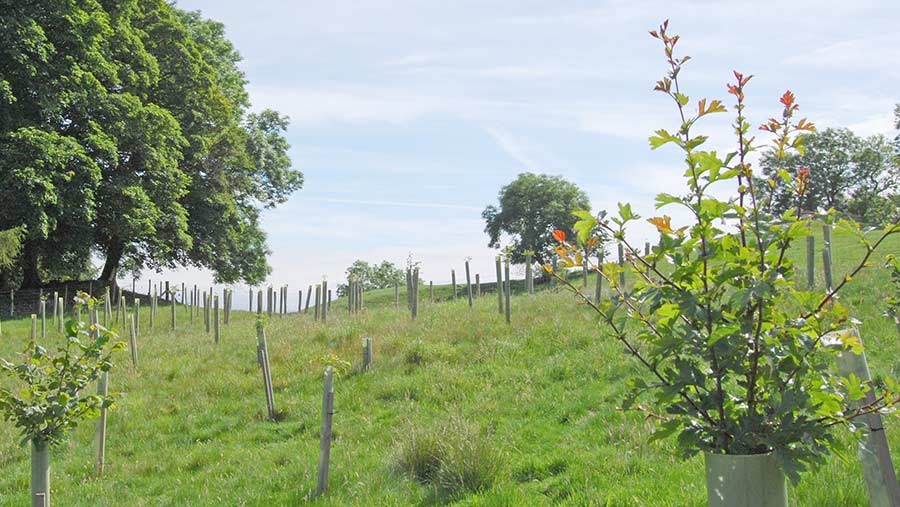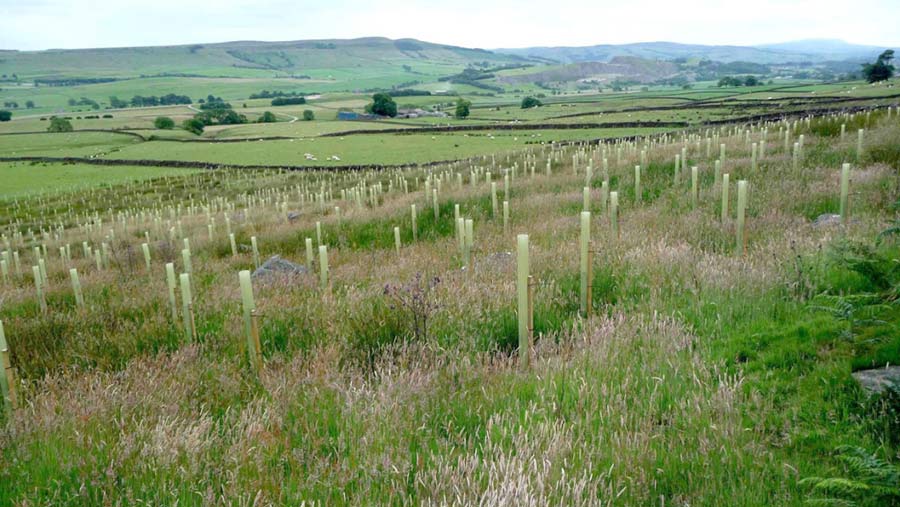Farming carbon: How to make money from new woodland
 © Yorkshire Dales Millennium Trust
© Yorkshire Dales Millennium Trust A government-backed scheme to reward farmers in England for storing carbon by converting farmland to woodland is set to offer landowners a guaranteed income for up to 35 years.
A fledgling trade in selling carbon credits to corporate buyers looking to offset the emissions they generate already exists, but variability in the market has not instilled confidence among farmers.
However, the launch of the Woodland Carbon Guarantee in November – an incentivised scheme to address the “climate emergency” and accelerate woodland planting rates – enables landowners to sell their sequestered carbon dioxide for a long-term guaranteed price.
See also: Q&A: Should you consider agroforestry on your farm?
The scheme
Currently only available in England, the £50m Guarantee allows new tree planting projects registered with the Woodland Carbon Code to sell verified Woodland Carbon Units (WCUs) to the government for a guaranteed price over 30-35 years.
Existing woodland is not eligible for this scheme.
Approved applicants participate in online reverse auctions, offering their best calculated price per WCU – equivalent to one tonne of carbon dioxide.
The government then agrees to buy successful bids until 2055/56 subject to the status of the woodland being verified five years after planting and then every subsequent five or 10 years.
Applicants will also have the opportunity to sell WCUs to the private sector instead if it commands a higher price, but will still be subsequently able to return to the terms of the government contract if the market is lower at the following break point.
The price paid by the government will rise in line with with the 12-month Consumer Price Index measure of inflation in April of each year from the start date of the project.
The scheme only accepts applications from projects registered with the Woodland Carbon Code, and although no auctions have been held yet, WCUs sold to the government could potentially command higher prices over the life of the contract than would be attained on the open market, he says.
The first auction will be held between 12 noon on Monday 20 January and 12 noon on Friday 31 January and will be open only to applicants who have been approved by the Forestry Commission.
Further national auctions are anticipated every six months for the first four to five years, dependent on the rate of uptake and funds.

Calm Slate © Yorkshire Millennium Trust
Flexible scheme
The scheme favours the landowner, says Edward Shephard, Woodland Carbon Guarantee adviser at the Forestry Commission.
“Both the private and public sectors are responding to environmental pressures by looking at offsetting their own and their customers’ emissions. Buying verified carbon credits is a way they can achieve their objectives.”
The contract is also flexible, and should not be affected by Brexit concerns.
“Landowners will still be able to sell to the private sector at any point in their contract if the price or timing is more favourable,” explains Mr Shephard.
“And they shouldn’t be put off by political uncertainties, there is no reason why this project should be affected.”
Creating carbon woodlands
Planting woodland on less productive areas of land can help farm businesses boost their income while also benefiting the environment, says Matt O’Connell, project developer and owner of Sylvawood Agriculture.
Landowners can plant any species or type of woodland which suits the project site, with the amount of carbon sequestered dependent upon soil type, tree species and how the woodland is managed.
Oak has the greatest capacity for carbon sequestration over a lifetime, but is slow growing, while Sitka Spruce has a shorter lifetime but provides a faster return.
Grants are also available to cover some of the cost of the saplings, including through Countryside Stewardship, the Woodland Carbon Fund or HS2 Woodland Fund.
However, projects will not be eligible for the guarantee if work is started before an offer is received.
The landowner must ensure that their target stocking density is achieved, so it’s worth planting around 5% extra to account for this, says Mr O’Connell.
“Woodland provides an array of benefits besides this income opportunity; from livestock sheltering to flood prevention and from pollinator habitat to game management,” he adds. “Forestry income from carbon and timber is also tax free.”
Good time to decide
Now is a good time to decide whether to convert a small area of a farm to woodland, says Vicky West, UK Woodland Carbon Code Manager at Scottish Forestry.
“With a corporate price of £5-15/t of carbon dioxide alongside the guarantee, grants and funding, it is now a much more viable prospect than before,” said Dr West.
However, landowners may want to consider using a project developer to advise and assist with the planning, registration and validation/verification of the project, warns Mr O’Connell.
“If different farms have small parcels of land for conversion, we bring them into one group of projects which helps reduce costs. Verification can cost £800-£1,000; creating a group splits that bill.”
Project developers can also help to manage woodland throughout establishment and beyond, from applying for grants to assisting with woodland maintenance contracts, fencing requirements and pest control.
What to do next
- Check if you are eligible on the government website and register your project on the UK Woodland Carbon Registry. You will need a carbon sequestration forecast and projects must meet the following terms:
- Landowner commits to permanent change of land use to woodland
- The land must NOT have been wooded for at least 25 years
- Soil must have less than 50cm organic/peat layer
- Get validated – you will need to complete a project design document with the Organic Farmers and Growers or Soil Association and they will need to validate your project within three years of application.
- Stay verified – At year five and then every 10 years, survey your site, complete a progress report and get it verified. Projects can last up to 100 years.
